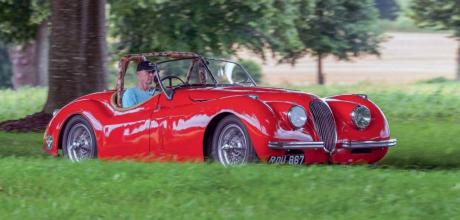1951 Jaguar XK120
Road XKs are cossetted and Race XKs are trailered – Geoff Ottley’s 120 bucks the trend. Words: Ray Ingman. Photography: Matt Richardson & Ray Ingman.
ROAD–RACE XK120A CAR FOR ALL REASONS
DRIVEN & RACED FOR NEARLY 40 YEARS – NEVER BEEN TRAILERED!
We discover the life and times of a well-used XK – and its owner!
If there was a prize for the longest period competing in the same Jaguar car, Dr.Geoff Ottley GP would be in hot contention for it. The only other challenger would probably be Derek Pearce with his Mk2, but most racecars have the ‘triggers broom’ factor and I suspect that a far greater percentage of RDU867 is the actual metal that left Coventry in 1951.
HISTORY
From the factory, the XK120 roadster’s first journey was to South Africa, but strangely the car was previously allocated with a Coventry registration. Little is known of its early history until it was reimported and purchased by Geoff in 1981. This was his first Jaguar product, and unlike the addiction illness that befalls most of us, his only example to date. Initially, the car was extensively used for family touring and holidays.
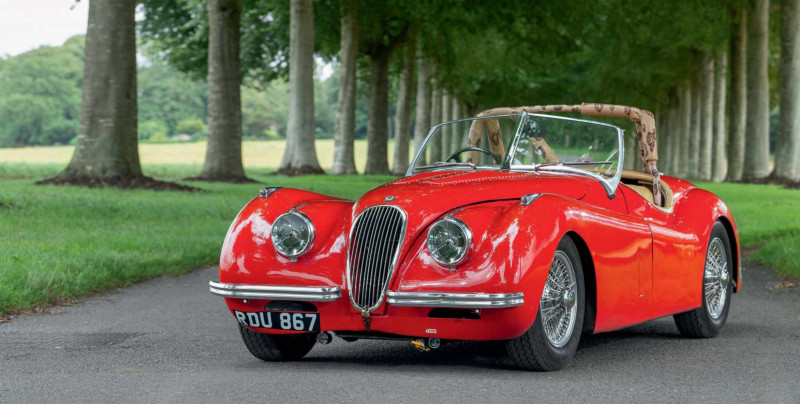
Long distance forays to spectate at the LeMans 24hr race and the Mille Miglia triggered an interest in competitive motoring. Conventional ownership no longer sated his driving passion, so the possibilities of competition were explored and acted upon. In 1985 the first race meeting to be entered was the then traditional ‘historic’ season opener – JDC Silverstone.
“Geoff’s competitive ambitions didn’t begin and end with circuit racing, inspired by the historic exploits of Ian Appleyard, he embarked, in parallel, on a rallying career”
This was supplemented by a season’s competition in the HSCC (Historic Sports Car Club) Novice Championship to get his feet under the racing table. From this modest beginning, activities expanded exponentially, and Geoff has subsequently entered innumerable races, not only at virtually every British circuit but also taking in Continental events at such historic venues as Spa, LeMans, Croix, Dijon and the Nürburgring – netting many class wins along the way. A particularly proud moment was to participate in the last ever race to be run on the iconic Montlhery banked circuit, located near Paris. A venue unfortunately made infamous in Jaguar lore by the fatal accident that befell Peter Lindner’s Lightweight E-type in 1964. Geoff’s competitive ambitions didn’t begin and end with circuit racing, inspired by the historic exploits of Ian Appleyard, he embarked, in parallel, on a rallying career.
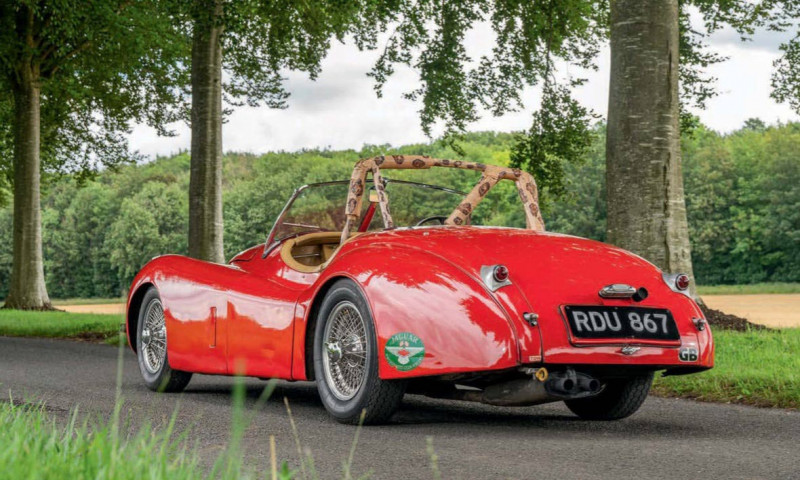
Enabling him to experience marathon events such as the Targa Florio, Leige-Rome-Leige, Coppa d’Italia and the Vltava Rallye in the Czech Republic. Where possible, holidays have been incorporated into these adventures, making the life of this XK120 seem all the more remarkable. Rather more so because during the nigh-on 40 year continuous competition history, the car has always travelled under its own power.
The only other car Geoff has ever raced was a Lotus Europa for a brief period – quite a contrast to the XK!
… NEVER ON A TRAILER
What further sets Geoff apart is his habit of driving his car to (and almost invariably, from!) meetings, enjoying the journey as much as the destination. Back in the ‘80s, transporting cars was the exception rather than the rule. Some series even insisting on road use and consequent MOT certificates. Fast forward four decades and paddocks are bursting at the seams with trailers, transporters and motorhomes. I am aware of no other Jaguar competitor following the good doctor’s example. Perhaps if the original fashion still pertained, on track driving standards would be improved?
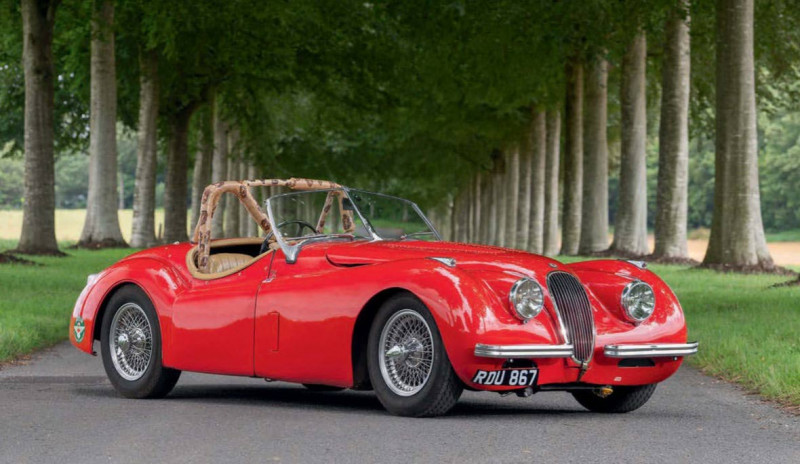
THE SIGMA CONNECTION
Peter Lander, the quietly spoken owner of Gillingham, Dorset based Sigma Engineering doesn’t court publicity, or indeed need to – his engines power a surprising number of Jaguar race cars, but only the cognoscenti are aware. He credits Geoff and fellow Dorset XK racer Rob Newell equally with his foray into Jaguar specialisation from a more general garage business forty years ago.
He has been responsible for all the 120s mechanical matters since its earliest days in Geoff’s custody. When JEC Racing presented Geoff with the Norman Dewis trophy for his XK mounted exploits, he immediately dedicated it to Peter and his preparation skills. Predictably, Peter would hear nothing of it, opining that the driver makes the difference – Geoff begs to differ! Geoff holds him in such high regard, he personally fashioned a label crediting his engine building skills on the nearside cam cover. Peter is predictably not entirely comfortable with this! In fact, those in the know will recognise Peter’s signature matt finish on the cam covers, he reasons that polishing is a waste of valuable time and has no effect on power output.
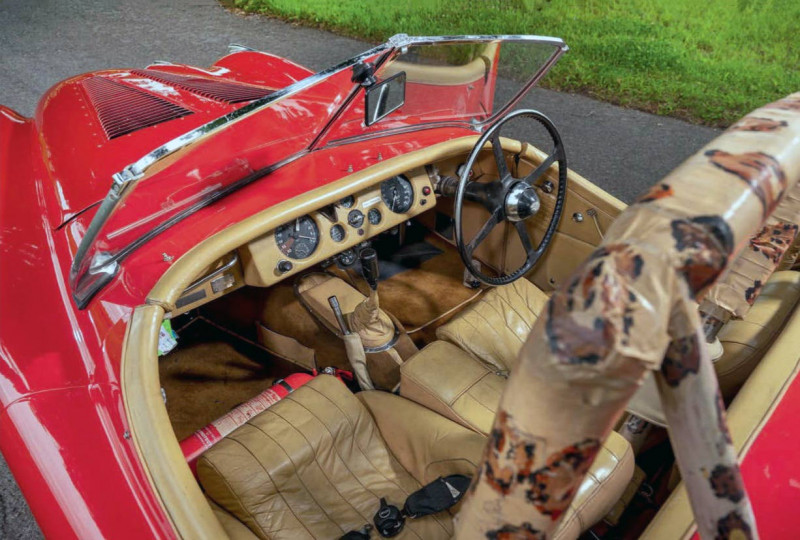
Whilst discussing the inner secrets of mechanical specification – Peter observes the carefully fashioned spark plug shroud and comments that every time he sees the car, Geoff has fiddled with something, and it’s got worse since his retirement six years ago! Geoff correctly justifies himself by countering that, because of the bonnet louvres, inclement weather results in the spark plug well filling with water with consequent misfiring – hardly ideal at a race start!
SPECIFICATION
So much water has flowed under the 40 year automotive bridge, that in talking to Peter and Geoff, it is hard for them to determine exactly what has been done to achieve the car we see today. It is fascinating to look around it and observe the developments which have taken place since its earliest competition days. Glancing down the bulkhead, the eye is drawn to a rather personalised interpretation of the compulsory engine breather catch tank – instead of a conventional alloy fabrication – an old Italian olive oil can is employed, a possible relic of a Targa Florio adventure?
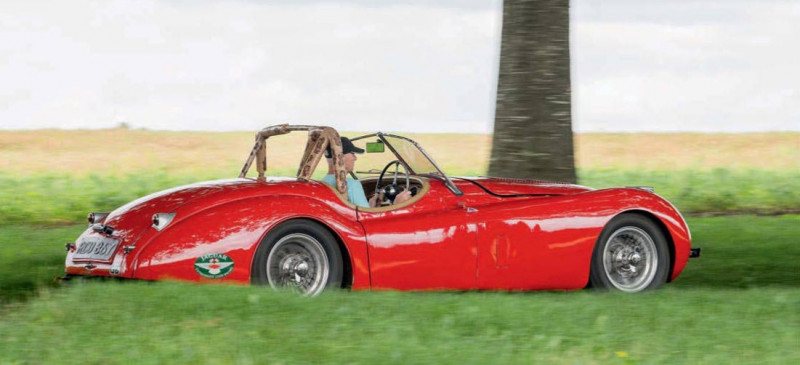
A cursory glance first reveals the roll cage, covered in an interesting interpretation of Jaguar skin. This complies with current racing requirements (as well as a sense of self-preservation!), as do the full harness belts, plumbed in fire extinguisher, towing eyes and LED high intensity rear rain light.
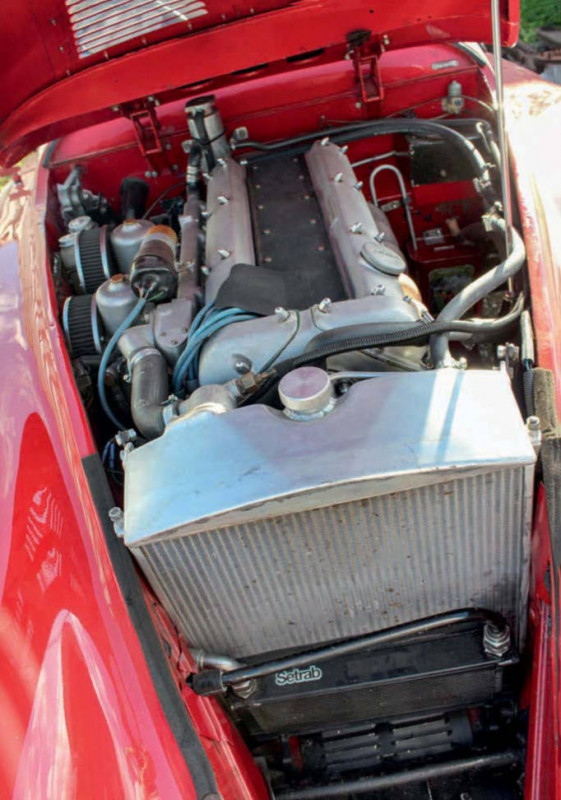
Others visual deviations from standard include the louvred bonnet and deletion of the rear bumper. The interior trim is largely complete and wears a wonderful age and use related patina. At first sight the seats appear to be period racing buckets – but further inspection reveals that they are aftermarket replica AC Cobra seats, modified with slots to allow the use of the competition full harness belts and leather trimmed to match the rest of the interior. Use has imbued them with a lustre of originality, which is enough to convince sceptical FIA scrutineers of their eligibility. As the car is often shared with his different body proportion brother, matching removable lumbar supports have been fashioned to suit the needs of both siblings. Peter believes the 3.4 litre cylinder block to be the original numbered component, but the B-type cylinder head is a later addition, fully gas flowed but fitted with standard camshafts, designed to retain road tractability. Race camshafts have previously been tried but rejected due to their unsuitability for road use. 2” Sus have recently superseded the 1.75” originals in the ongoing quest for a little more power. The exhaust manifolds remain standard but mated to a large bore straight through system which gives a wonderful distinctive burble or howl – depending on the revs employed! The car is fitted with a later 4-syncho gearbox with an uprated overdrive, clutch actuation is hydraulic, replacing the original mechanical system. The overdrive is actuated by a neat switch inset into the gearknob. Overdrive is another pet peeve of Peters, reasoning that it is just another thing to go wrong. But ideal for long road journeys, both in fatigue minimisation and fuel consumption improvement.
The car is never considered to be ‘finished’, instead continuous development is the watchword. One particular area is cooling – always a marginal factor on XKs, the obligatory aluminium radiator is supplemented by occasional variations in oil cooler location, electric cooling fan configuration, and header tank / swirl pot design. all subject to periodic revision with view to seeking the ultimate solution to temperature management.
…HE DOES IT HIS WAY
I suspect Frank Sinatra never raced a classic Jaguar, but Geoff certainly adheres to the sentiments of his song.
He has never had the wish to modify the car excessively but has fixed ideas on his desire to compete in an ‘original’ car. One nod to traditionalist OE specification is 16” diameter wheels, in this case alloy rimmed Borranis with stainless steel spokes. The downside of not reducing the diameter to the more usual 15” is a restriction of tyre choice, the car usually competes on 185x16 Vredestein Sprint Classics, once the control tyre of the JECs XK Challenge race series. For some events, the rather expensive Dunlop L section tyres are used, but are technically not road legal, so don’t accord with Geoff’s ethos.
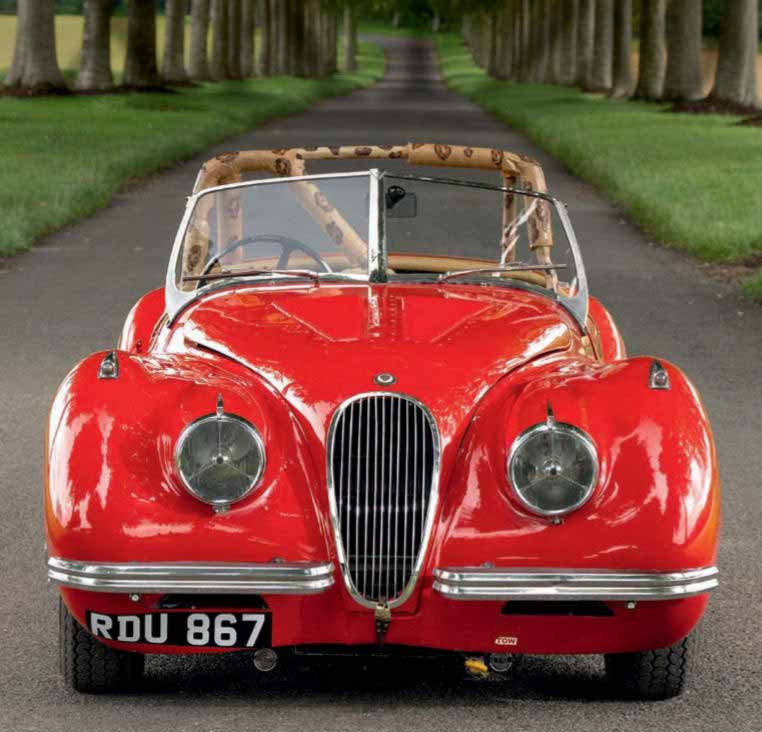
Geoff cites the most revolutionary modification he has ever made, in 2002, was converting from drums to disc brakes, mirroring Jaguar’s own experience with the C-type. The consequent reduction in lap times has never been equally by any other development. Early experiments with the adaption of Mintex truck brake shoes, whilst moderately successful, pale into insignificance.
At stages of its competition career, the car has had ‘FIA papers’ (now known as HTP – Historic Technical Passport). But these restrict modifications strictly to only those components available in period. Geoff has modified and developed the car for his own enjoyment and reasons that the current lack of ‘papers’ (and their resultant expense) do not seem to preclude him from the type of events he wants to enter. It will be a cold day in hell when he reverts to drum brakes!
ANNECDOTES ABOUND
Never has the phrase ‘too many to list’ been more apt. The main problem with our ‘interview’ was its propensity to veer off on various conversational tangents, chatting about shared friends, acquaintances and venues. Geoff and I started Jaguar club racing at a similar time, but strangely, results sheets reveal our paths seem to have crossed only once: Zandvoort in 2002. Another factor we share, is that during his competition career, he has never won a race outright, but that is not his primary objective. Enjoyment and adventure being the motivation. Often sharing the experiences with his brother, David. Whilst reminiscing, and reviewing his extensive collection of personal memorabilia, Geoff was amazed at the doors his XK has opened and the experiences it has afforded him.
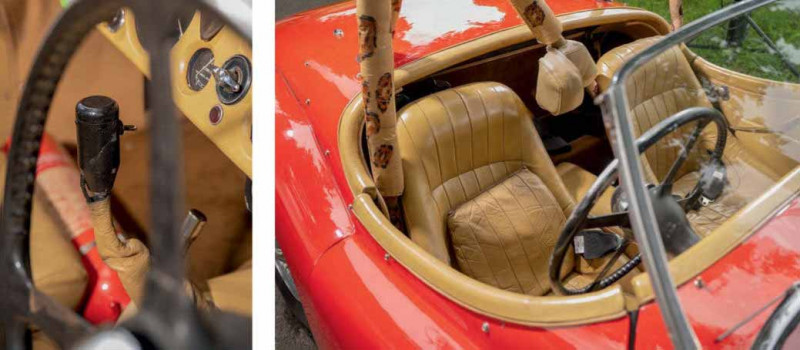
His foray on the RAC Rally is remembered fondly and reference to the entry list revealed he shared the route with such legendary personages as Roger Clark, Timo Makinen and Ruano Aaltonen. Similarly, the Vltava rally included Walter Rohl.
At Spa in 1993, he felt he was credited with an incorrect practice time which saw him line up 9th on a grid of 50 or so cars. In his immediate vicinity were genuine D-types driven by the likes of John Harper, Frank Sytner and Gary Pearson – with many quicker cars behind. His protestations to the timekeepers fell on deaf ears (they do not make mistakes!) resulting in what could be fairly described as ‘busy’ early laps as the status quo was re-established One memorable meeting and concurrent holiday involved a drive from Dorset to Zandvoort in Holland than straight to Knockhill for another race event then onward for a Scottish sabbatical – then home again. All with his wife, Lisa at his side. Thank goodness for overdrive (sorry Peter!).
Whilst on the Coppa d’Italia road race, a very minor navigational miscommunication between the brothers resulted in RDU lying in its side in a ditch. Help from a local farmer soon had the wheels returned to tarmac. The rally was successfully completed, resulting in a ‘Spirit of the Event’ trophy. But unfortunately, on the way home through France, due to the previous damage, one of those wheels detached complete with hub and the broken end of a half shaft. This, unsurprisingly, resulted in a ride back to England by alternative means. The car was stored in a local garage, awaiting Geoff’s return carrying a replacement half shaft as hand luggage. Use of the garage’s facilities had the car reassembled in short order, once again returning to home soil under its own power – still no trailer!
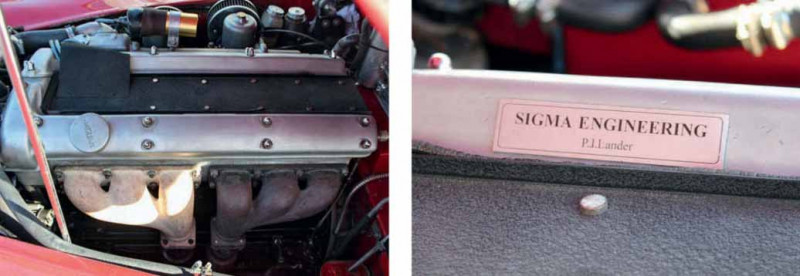
Dr.Ottley professes no great mechanical knowledge, but in conversation with him, I feel he is being economical with the truth. No one can have accomplished all these adventures without!
Until recently, Geoff has kept all his related memorabilia and trophies carefully archived — witness the wooden box! But he has never had the time to fully collate them. My visit with its ensuing trawling of records, pictorial and written, has motivated him to start a photo journal of his XK related exploits – each image triggering a fresh memory – perhaps he ought to consider writing a book! I’m looking forward to reading it!
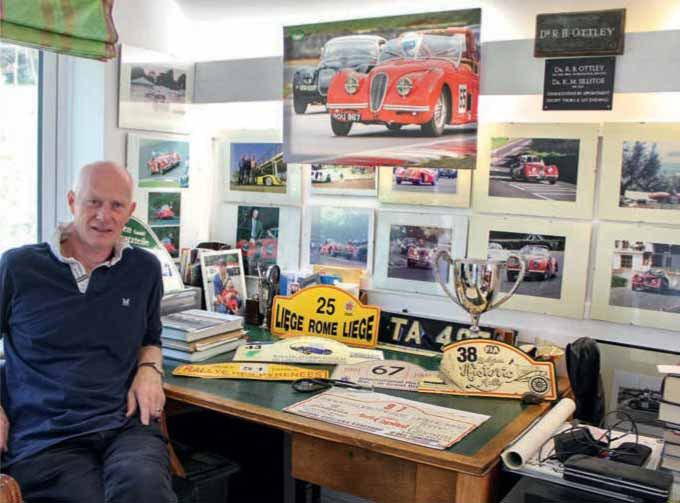
“He has never had the wish to modify the car excessively but has fixed ideas on his desire to compete in an ‘original’ car.”


